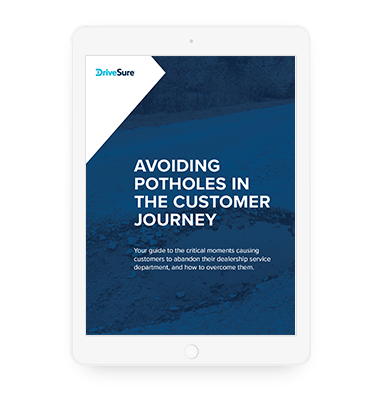Whether they’re buying a new car or having their vehicle serviced, you want your customers to be happy and satisfied with their dealership experience. A happy customer is a loyal customer.
But the car-buying process can be filled with challenges and frustrations. From long wait times to poor communication, customers leave many dealerships feeling less than thrilled — and many won’t even return at all.
Worse still, a few bad reviews can cause any potential new customers to look to a dealership’s competitors instead.
So what are the top complaints that leave vehicle owners with a sour taste in their mouth? Let’s group these into some broader categories:
Prepare for the 5 make-or-break moments that can cause service customers to start going elsewhere.
Poor communication
Some of the biggest complaints in the service lane boil down to communication failures. Improving communication practices can go a long way toward improving customer relationships. Most complaints revolve around these three things:
- Lack of Responsiveness: a customer who has been waiting for your reply to their email inquiry about the availability for a specific part for their vehicle, only to receive no response. This customer is left feeling ignored and frustrated, and may even start to question the level of customer service your dealership provides.
- Lack of Consistency: a customer calls your service department seeking information about a repair they need, but they can’t get a clear answer. The customer is transferred from one department to another, and they are given conflicting information. This inconsistency leads to confusion and mistrust in the customer’s mind.
- Lack of Coordination: a customer schedules an appointment for a specific time, but when they arrive at the service center, they are made to wait for an hour without an explanation. This customer’s time is valuable, and they are left feeling disrespected and frustrated — and probably take their business to a competitor.
- Lack of Clarity: a customer comes in for an unscheduled visit only to find they misunderstood whether their new car warranty covers tire repair or replacement. Frustration often gets directed at dealerships, and service managers may cover the cost to avoid losing the customer relationship. Either way, it’s lost revenue.
To avoid complaints related to these issues:
- Give Timely Service Updates: Customers appreciate receiving timely updates on the status of their vehicle service. Whether through email, text message, or a simple phone call, keeping customers informed helps build trust and confidence.
- Over-Communicate: Provide customers with candid, clear, and concise information about the services being performed on their vehicle, as well as any necessary repairs or maintenance, to help ease any concerns and foster a positive experience. It’s better to err on the side of giving too much information. Don’t try to hide mistakes or unpleasant surprises from the customer.
- Keep Knowledgeable Service Staff Available: make sure someone is always on hand who can answer questions accurately and efficiently. Customers will value this, especially when there’s a high-performing service advisor to keep everything running smoothly.
- Maintain a “Single Source of Truth”: this can usually go without saying, but if you don’t already have an organized process for appointments and scheduling, you need one. Your staff should all be able to immediately verify which vehicles are being serviced and when. When repairs go longer than expected, refer to the first two suggestions here, or consider expanding your service lane capacity.
- Remind Customers of Coverage Options: issues like confusion around warranty coverage are a hassle for everyone. Find opportunities to remind customers if they’re not covered, and mention coverage like road hazard warranties. Sometimes warranty coverages fail through though, so consider additional options. For instance, some dealerships partner with DriveSure to offer vehicle owners additional road hazard protections and service benefits through a perks package that renews with regular oil change services.
Why does poor communication lead to so many issues? In short, by failing to communicate, you send the message that you’re trying to hide something or that you don’t care about your customers. In short, it makes them wonder if you’re guilty of something dishonest.
Dishonest tactics
These are the most obvious ways to send a customer running to your competitors. In a difficult market, some dealerships feel pressure to boost revenue at any cost, but using unethical approaches like these is a quick way to cause devastating damage to your business. Complaints like these are most likely to hurt your business:
- Pushing Unnecessary Repairs: a customer brings in their vehicle for a routine oil change and is told that they need major repairs, such as new brake pads or rotors, even when they don’t. The customer feels pressured and frustrated, and they may question the honesty of your service technicians. Many customers have been burned like this in the past, and it makes them especially conscious of anyone else trying the same.
- Bait and Switch: Picture a customer who arrives at your service center, ready to have their vehicle repaired, only to find out that the quoted price has changed or additional work has been added without their approval. This leads to angry customers who will question the honesty of your service technicians.
- Price Gouging: similarly, when vehicle owners are at the mercy of the dealership (due to the current supply chain issues, or simply a lack of repair knowledge) some dealerships will charge an excessively high price for services. The customer leaves feeling resentful — especially if they believe they were taken advantage of due to a lack of knowledge or experience in the maintenance and repair process.
- Misleading (or Outright False) Advertising: in this variation of what is still just a bait and switch, the customer calls your service center to schedule an appointment, based on an advertisement they saw for a discounted oil change. Then when they arrive at the service center only to find out the deal was not available or that additional work was required to receive the discount. This can lead to a loss of trust in your dealership and a negative experience for the customer.
To overcome these issues:
- Avoid Dishonest Tactics Entirely: the first and most obvious thing here is to avoid these practices altogether, which is simple enough.
- Keep Everything Up to Date: ensure that info provided online is up to date and accurate, and that the service staff and online staff are in sync with each other.
- Maintain Fair Prices: from purchasing a car to getting a repair, vehicle owners who feel they’re getting competitive (or fair) prices are more pleased with their dealership, and more likely to stay loyal.
- Address the Elephant in the Room: dealerships can’t pretend that buyers don’t have preconceived notions based on past experiences. Instead, your team needs to use this knowledge to build relationships with customers. Sometimes, simply acknowledging that the customer probably has these concerns can go a long way to help make them feel comfortable.
Poor Customer Service
While not as severe as being dishonest, these practices also lead to a loss of trust in your dealership and a negative experience for the customer.
- Unsatisfactory Treatment: the customer arrives at your service center, ready to have their vehicle serviced, only to encounter rude, unhelpful, or uninformed service advisors. This customer leaves frustrated and disrespected.
- Lack of Transparency: picture a customer who calls your service center with a concern about their vehicle, only to receive vague or evasive answers from the service advisor. This customer feels like they are not being treated with honesty and respect, and they may question your dealership’s business practices.
- Preferential Treatment: the customer comes in for maintenance, only to feel ignored or overlooked because they don’t fit the profile of a typical “high-end” customer. Providing fair and equitable treatment to all customers, regardless of their appearance or vehicle type, is essential for building trust and maintaining customer loyalty.
Improving customer service can vary depending on your issue, but here’s how to start:
- Implement a Feedback System: encourage customers to provide feedback on their service experience. Use this feedback to identify areas of improvement and make changes to enhance the customer experience. Letting customers channel any dissatisfaction here (and responding constructively to it) can also help avoid negative reviews or damaging word-of-mouth.
- Promote Fair Treatment: make sure that service advisors understand that all customers should be treated with respect and fairness, regardless of their vehicle type or appearance. Encourage a culture of inclusivity and equality in the service lane to build trust with customers and maintain customer loyalty.
- Make Sure You Have Enough Technicians: sometimes issues simply result from a lack of staff to help everyone in a timely manner. Despite the technician shortage, there are still ways to find more.
- Additional Staff Training: additional training can improve the overall customer experience. By providing employees with the necessary skills and knowledge, they are better equipped to handle customer concerns and consistently provide effective solutions. DriveSure provides clients with free training modules to help with this.
By proactively improving your dealership’s practices, service directors and fixed ops can ensure customer satisfaction, maintain customer loyalty, and keep a steady flow of positive feedback that will boost your dealership’s local reputation.
Be sure to prioritize your customer experience, and continually evaluate and improve how your service drive operates. For more tips on improving customer satisfaction, read our previous article on the topic, or learn about the major defection points that cause customers to go elsewhere.
Master These Moments to Keep Your Customers
Discover the 5 critical moments causing customers to abandon your dealership service department, and how you can overcome them.


